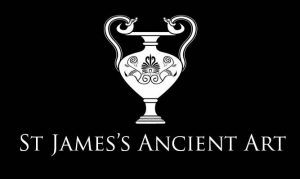This scarab documents the changes that occurred during the late Middle Kingdom to the bureaucratic system which led to an increase in official scarab seal productions. Scarabs were mass produced to deal with demands and thousands bare the names and epithets of court officials. They were used for administrative purposes; to seal documents and monuments. The official named on the scarab, Khenemshu, is also known as Khentikhety-hotep. He was an official and mining leader of the Twelfth Dynasty, working under the pharaoh Senwosret III. He is named on a stele of Senebsumai, as the benefactor. Some records also state that Khenemshu was the ‘child’ of Senebsumai, possibly his successor.
Egyptian Steatite Scarab of the Overseer Khenemshu
£ 1,395.00
A large, Egyptian, steatite scarab with hieroglyphs to the reverse. The obverse features a stylised head and clypeus, formed from gentle moulding and incised lines. The prothorax and elytra are formed from slightly curving linear marks. The reverse features two vertical registers of clearly incised hieroglyphs, detailing the name and title of a private official. At the top is a long horizontal sign, described by Gardiner as a ox tongue and transliterated as ‘imy-r’. Underneath is a rectangular sign, described as a house and transliterated as ‘pr’. The name of the owner follows. The round striated disc transliterates as ḫ (kh), the water ripple ‘n’, the owl ‘m’ and the feather hieroglyph ‘šw’. Together these would transliterate as ‘Kh-n-m-shu’, or ‘Khenemshu’ if the vowels are added. The final two hieroglyphs to the left close with an epithet; ‘neb’ ‘im3ḫ’, which would translate as ‘devoted to his lord’.
The hieroglyphs read alltogether as; ‘imy-r pr sw kh-n-m-šw nb im3ḫ’
This translates as ‘Overseer of the estates, Khenemshu, devoted to his lord’.
The scarab belonged to Khenemsu, the estate overseer.
Period: Circa 12th Dynasty, Middle Kingdom
Provenance: Ex private collection Mr MT. Ex AH private collection.
Condition: Very fine condition. With clear hieroglyphs.
SOLD
| Weight | 4.25 g |
|---|---|
| Dimensions | L 2.1 x W 1.5 x H 1 cm |
| Region | North Africa |
| Stone | Steatite |
Reference: For the same official name: The Petrie Museum of Egyptian Archaeology, London, UK, item LDUCE-UC11406










